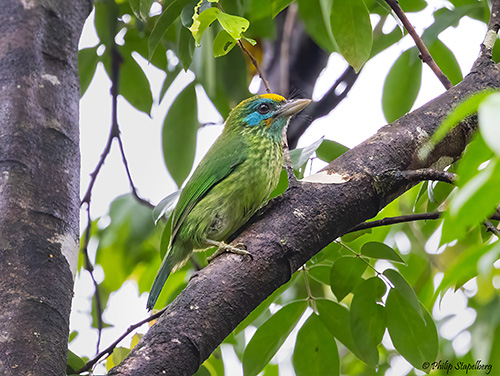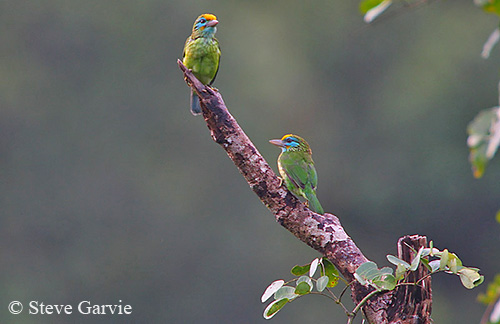
Fr: Barbu à front d’or
Ang: Yellow-fronted Barbet
All: Goldstirn-Bartvogel
Esp: Barbudo Frentigualdo
Ita: Barbetto frontegialla
Nd: Ceylonese Baardvogel
Sd: gulpannad barbett
Photographers:
Steve Garvie
RAINBIRDER Photo galleries
Philip Stapelberg
GALLERY
Alan & Ann Tate
AA Bird Photography
Text by Nicole Bouglouan
Sources:
HANDBOOK OF THE BIRDS OF THE WORLD Vol. 7 by Josep del Hoyo-Andrew Elliott-Jordi Sargatal – Lynx Edicions – ISBN: 8487334377
Yellow-fronted Barbet
Psilopogon flavifrons
Piciformes Order – Megalaimidae Family
INTRODUCTION:
The Yellow-fronted Barbet is endemic to Sri Lanka where it occurs mainly in the hills, up to 2,000 metres of elevation, but it also frequents many parts of the low-country wet zone. It is less common in the dry zone.
This species is primarily a fruit-eater, but the young are occasionally fed on insects and other animal matter. Several birds can be seen feeding silently on the same fruiting tree.
The breeding period takes place during two marked seasons. Both adults excavate a nest in Bombax or Doona tree, often 3-10 metres above the ground. Both parents share all the nesting duties.
The Yellow-fronted Barbet is a restricted-range species, but it is common and adaptable. It is not globally threatened at the moment.

DESCRIPTION OF THE BIRD:
Biometrics:
Length: 21-22 cm
Weight: M: 57-60 g
The barbets get their name from the bristles around the base of their heavy bills.
The present species is a medium-sized, plump bird. It has large head, short neck and short tail.
The Yellow-fronted Barbet has green body plumage. Upperparts, upperwing and tail are darker green than the underparts which are mostly yellowish-green with darker green scaling on the breast.
On the upperwing, the outer flight-feathers show dark grey edges. The undertail is greyish-blue.
On the head, forehead and crown are bright yellow. Face, chin and throat are blue. Nape and hindneck are mixed yellow-orange and green while joining the green upper mantle.
The thick, sturdy bill is horn-coloured, with rictal bristles at the base, and small yellow patch at the gape.
The eyes are brown.
Legs and feet are pale flesh.
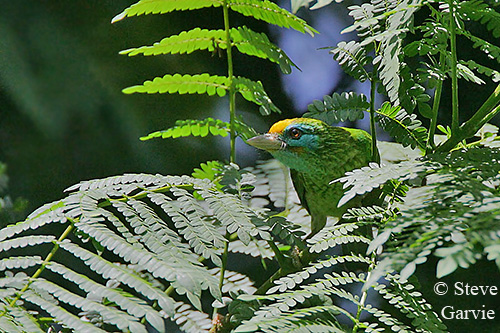
The bristles are visible
at the base of the bill
Male and female have similar appearance, but the female is slightly smaller with smaller yellow patch at bill base.
The young bird has streaked upperparts and is duller than adults.
RANGE:
The Yellow-fronted Barbet is an endemic resident breeder in Sri Lanka.
HABITAT:
The Yellow-fronted Barbet is an arboreal species. It occurs in subtropical and moist forests to wetlands, and also frequents plantations where it can find berries and fruits.
Very adaptable, it can be found in small gardens and other different habitats, from sea-level up to 2,000 metres of elevation.
It is the commonest barbet of the hill-country between 1,000 and 2,000 metres in the wet zone, but it also occurs in the low country. In the dry zone, it is found in suitable damp areas.
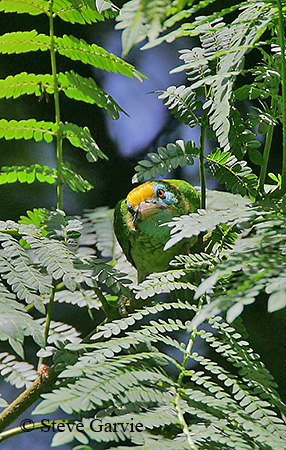
CALLS AND SONGS: SOUNDS BY XENO-CANTO
The Yellow-fronted Barbet gives metallic calls “qui-ock, qui-ock” often uttered continuously.
The call is often preceded by a rolling, high-pitched “krrrrr”. The pair keeps in touch by calling.
The song is a variable series of “toowo” or “too-ka-o” notes, and usually starts with a fast ‘towowowow” before slowing. It may last two or more minutes.
Then, the birds remain silent for much of the day, becoming more vocal in the evening.
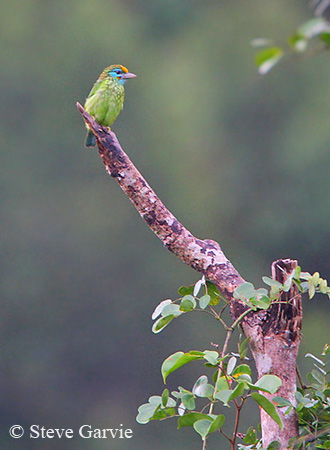
BEHAVIOUR IN THE WILD:
The Yellow-fronted Barbet is primarily a fruit-eater, but animal food is also taken, especially to feed the young. It is an arboreal species.
It feeds on berries and wild figs, and also takes cultivated fruits including guavas and pawpaws. It is sometimes considered a pest in orchards.
The Yellow-fronted Barbet is always active and agile while searching for food. It usually occurs in mid and upper layers of the forest canopy. It is often seen in pairs or in small groups.
The Yellow-fronted Barbet has two breeding periods. Both adults share all the nesting duties including nest-building, incubation and chick-feeding. The nest is a hole excavated in tree by the birds themselves, and this work may last about two weeks.
Nothing is known about the courtship displays, but we can suggest that the beautiful plumage, and especially the colourful head, play a role during the displays.
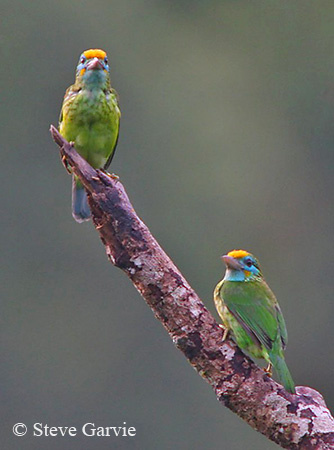
The Yellow-fronted Barbet is resident and probably sedentary in Sri Lanka.
Some movements may occur in the drier areas of the habitat, especially to forage for fruits.
The barbets are not particularly fast fliers, although some are faster than others. They usually disperse about 10-12 km beyond the borders of their habitat.
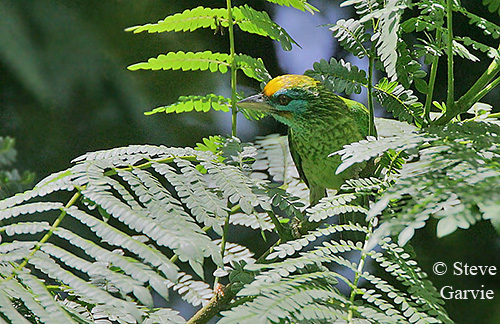
REPRODUCTION OF THIS SPECIES:
The Yellow-fronted Barbet has two breeding periods. The first one takes place from February to May, and the second one in August-September. However, occasional nests may be found at other times of the year.
It nests in tree holes excavated by both mates. The nest is placed in vertical, often decayed tree branch or stump, usually between 3 and 10 metres above the ground. It may be occasionally lower, about 2 metres from the ground level.
This work lasts about two weeks.
The cavity inside is oval, and the entrance is about 25 cm. Such nest is sometimes used in several following year. It is then dug deeper each year and may reach 50-60 cm in depth. This species does not use nesting materials.
The female lays 2-3 pure white eggs. The incubation lasts about 14-15 days, shared by both adults.
The young are fed on fruits and berries, but also on insects and other animal food. They are fed by both parents.
